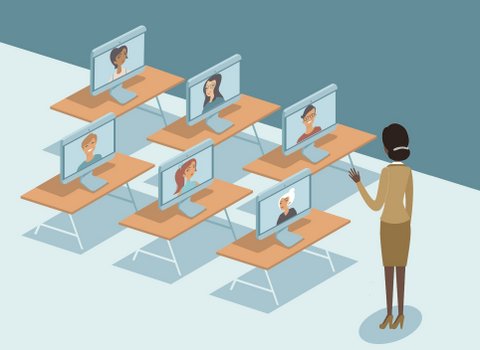
29 Jul Schools Scramble to Teach Teachers How to Educate Virtually

(Image via iStock; modifications by Anne Wernikoff for CalMatters)
By Mikhail Zinshteyn, CalMatters
For most California students in schools and colleges, the fall term will look like the middle of spring: online with little to no in-person instruction.
But if students and parents accepted the rapid switch to online in March and April as an emergency need while a pandemic spiraled out of control, their expectations for fall will be different.
“With a number of months to prepare, that same grace and gratitude probably won’t be there,” said Brad Rathgeber, the CEO of One Schoolhouse, a Washington D.C.-based consortium of 218 mostly “independent” private K-12 schools that offers online coursework to students and trains teachers readying for a virtual fall.
Schools at every level have tried different strategies to prepare teachers for distance learning in the fall, from paying companies like One Schoolhouse to developing their own training curriculum.
Here’s a look at how some of that is shaking out.
Spring training
When teachers rushed to move instruction online back in March, “they were basically taking what they did in their face-to-face classrooms and finding an online equivalent,” said Rathgeber.
But the rules of in-person instruction don’t fully apply to teaching virtually. Educators need to spend considerable time learning not just the new digital tools but totally different strategies for teaching students who’ll likely never set foot in a classroom this fall.
Experts say teaching is about building relationships. Without the ability to see students in-person, how can schools and colleges forge the human element that can easily go missing in a virtual environment? One strategy is for teachers and professors to organize group learning activities over video conferencing software. Another, which takes time to get right, is figuring out what content should instructors prioritize for live instruction and what can be assigned as homework for students to review, such as explanatory videos or articles to prepare for a live discussion.
“What happened this past spring was pretty terrible, and we need to get it better.”
ALIX GALLAGHER, POLICY ANALYSIS FOR CALIFORNIA EDUCATION
One Schoolhouse charges schools $300 per teacher for approximately 15 hours of training for teaching virtually, or $450 if the school isn’t part of the One Schoolhouse consortium. Several California schools took on those services, Rathgeber said, including Marin Academy, a private school in San Rafael where all roughly 70 teachers and faculty took part in the training. One Schoolhouse also provides free training to any teacher outside its network through webinars.
Los Angeles Unified School District, California’s largest, in May created 30 hours of online training to ready teachers for distance learning. More than 11,000 teachers completed the training, just under half of the district’s teaching corps.
Public and private universities are running faculty training programs this summer to help them create virtual courses and teach them techniques for improving student learning online. Some are even offering faculty stipends to learn the virtual instruction ropes.
For California universities that made early decisions to move most, if not all, instruction online for fall term, the summer has been smoother. By focusing on online teaching, the fall learning plan “is coherent from beginning to end and doesn’t have a lot of this flipping back and forth” between scenarios that bring instruction back in person mid-term, said Deanna L. Fassett, assistant vice provost for faculty development at San Jose State University, where all instruction is expected to be remote in the fall.
An ideal plan for K-12 teachers
For K-12 schools, training faculty for an online fall is key, says Alix Gallagher, director of strategic partnerships at Policy Analysis for California Education, an education research center made up of faculty from several premier California universities that last week published a guide for schools to prepare for online learning. “What happened this past spring, I’ll say as a researcher and parent, in general, was pretty terrible and we need to get it better,” Gallagher said.

Alix Gallagher, director of strategic partnerships at Policy Analysis for California Education, says it’s important for educators to use their digital platforms as a way for students and instructors to interact with each other and leave lectures as something students can watch individually. (Anne Wernikoff / CalMatters)
Learning the bells and whistles of technology is important but the training can’t stop there. She’d like to see district headquarters, which have curriculum specialists on staff, develop model lesson plans for a variety of subjects that can be imported to a virtual fall.
The models should include guidance for teachers on what kind of learning can happen synchronously — the term used to mean live virtual instruction — and what can be assigned for students to learn on their own time, she said.
That’s where familiarity with the technology is important. Teachers should know how to organize virtual breakout rooms on Zoom, the popular video conferencing software that’s become ubiquitous in the era of COVID-19, to schedule group discussions among students to better reinforce the content they’re trying to teach.
To improve classroom security, teachers should also know how to create login credentials so that only students assigned to the class can enter the video meetings, Gallagher said.
That training should be ongoing, because “there will probably be a long learning trajectory for teachers,” Gallagher said. She recommends districts restructure part of their school calendar to focus more on teacher training. The training can also look like the lesson plans teachers will be developing — with some aspects done synchronously and others on-demand — and use the same tools teachers will work with while teaching students.
Teacher training isn’t the only focal point for schools; a substantial digital divide remains. More than 700,000 students still lack a computer and more than 300,000 can’t connect to the internet, according to the California Department of Education.
New state law says districts going virtual must ensure students have digital and online access to instruction, but other rules suggest districts will have to train teachers, too. In draft rules that the state has to complete soon, districts need to have distance learning plans. “Presumably, a quality distance learning program would have this training component,” said Troy Flint, spokesperson for the California School Boards Association.
The state freed up a $5.3 billion pot of money to help districts transition to virtual learning, including training for teachers.
Higher-ed strategies
University of the Pacific, a private university in Stockton with campuses elsewhere in the state, decided to go fully virtual in the fall July 17. Roughly 400 faculty out of nearly 900 at the university are taking online training on teaching virtually that the university developed in-house by the staff of the Center for Teaching and Learning.
Lott Hill, director of the center at Pacific, says the certainty of an online fall freed up a lot of energy to “improving instruction for teaching online.”
The training amounts to 35 to 40 hours of on-demand tutorials and web content that faculty learn at their own pace, plus ongoing live training where they can ask questions and discuss best strategies for the subjects they’ll be teaching.
Among other techniques, the tutorials recommend that faculty break up their on-demand assignments into smaller eight-minute chunks that are punctuated by short quizzes or writing assignments that allow students to reflect on what they just learned. That’s based on the science of learning findings that show the typical human attention span is limited.
University of California Berkeley has multiple waves of faculty training for a virtual fall, including an ongoing webinar series. The university was already planning to teach only a small percentage of classes in-person, but made the decision to go fully online last week after an outbreak of 47 COVID-19 cases that the university disclosed July 8.
“What we don’t want is for students to have frustration with the technology, so that they can focus on the content.”
TERRY JOHNSON, UC BERKELEY CENTER FOR TEACHING AND LEARNING
One concerted approach is an eight-week training program for 200 graduate student instructors that comes with a $5,000 stipend. Another is Semester in the Cloud, a campus undertaking to develop more than 40 courses for a virtual setting. These typically enroll hundreds of students each and are essential introductory and “gateway” courses for first-year students.
The university hired additional instructional designers and paired them with learning specialists and faculty — who’re also receiving $5,000 stipends — to build the courses. The collaboration is vital to developing online material speedily that in the pre-pandemic era would take much longer to engineer, said Terry Johnson, faculty director of the Center for Teaching and Learning at Berkeley.
Some design details are still being worked out. A team developing a chemistry course in Semester in the Cloud is searching for the right tool to capture the chemical equations students need to write out that software can automatically grade. The grading software can’t always accurately read the equations that students upload with their smartphone cameras because of camera glare or other lighting effects. One idea is for students to use a stylus pen to record their answers. Another is to use a simple scanner that just reads what’s on the page.
Other experts stressed the importance of tinkering on the backend to make the technology intuitive for students. Johnson doesn’t want “students to have frustration with the technology” and instead focus on the content.
One Schoolhouse’s Rathgeber agrees. A mistake he saw educators make in the spring was overwhelming students with technology, apps and links. “Actually, no,” he said. “You want to make sure that there’s a simplicity there.”
Federal funding
This summer San Jose State began offering full and part-time faculty $1,000 stipends to enroll in a three-week training institute for online instruction. More than 1,000 faculty heeded the call.
Diane Belger, a lecturer in accounting and finance, enrolled. Like the others in the training institute, she had to pass four mandatory training courses and take three others of her choosing from a pre-selected list, not unlike the required and elective courses of a college minor.
One key takeaway from the institute was that she doesn’t need to lecture as much during the live courses and can instead record her own videos or find ones on YouTube to explain key concepts to supplement assigned reading material.
“And then I can use my time with students to break them into smaller groups, to work problems with them,” Belger said. “Or to talk about what’s going on in the real world.”

Another strategy she hopes to employ is assembling more of her students into small groups for all of fall term, which she says will allow students to learn more from each other.
In addition to tech know-how and virtual curriculum planning, the San Jose State training also included courses intended to benefit faculty and students even after in-person learning resumes, like structural inequality.
In all, the university has spent about $2.5 million on faculty training and preparing for a virtual fall, including money for the stipends, hiring faculty trainers, bringing on mentors who each guide about 20 faculty members into the fall, and other software and equipment for students, such as engineering kits that are being mailed to them.
Much of the money came from the federal CARES Act, the March stimulus package that awarded the California State University system $563 million, about half of which went to students.
“We wouldn’t be able to do this at this scale without the CARES Act,” said San Jose State Provost Vincent Del Casino Jr.






No Comments